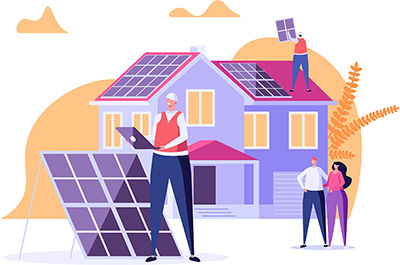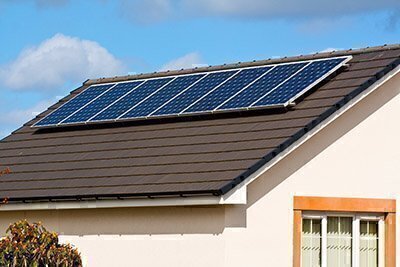Thinking About Going Solar?
Last updated July 2025
Although the cost of panels and other equipment has come way down over the last 10 years, the biggest obstacle for most homeowners when deciding whether to install solar energy systems remains price: For a 6.2 kW system, which would generate all of the electricity needed for the average house in this area, you’ll have to plunk down at least $18,000. You’ll get your money’s worth but it will take time, and starting in 2026, the payback period will be even longer.
On July 4, President Trump signed sprawling legislation that ends a long-time, popular 30 percent federal tax credit for residential solar projects. Industry experts predict that without the tax credit, far fewer homeowners will purchase systems.
You can still claim this credit if you complete a solar energy installation and pay for it before the end of the year. After that, there will still be generous incentives from Massachusetts and local utilities to help pay for solar projects. But after the valuable federal tax credit sunsets, a typical Boston area family with a roof that gets a lot of sunshine won’t recoup their solar project costs for eight years or more.
You can finance a solar project purchase to avoid spending savings. Installers offer loans or you can obtain a home equity line of credit. Alternatively, you can sign on with a company that supplies equipment via a lease or similar arrangement in exchange for paying it a flat monthly fee—typically $100 to $150 per month. We discuss here the pros and cons of leasing. In general, we don’t think these arrangements represent good deals for most homeowners; it’s better to buy and remain in control of your system.
If you decide to go solar you’ll have to make several decisions, and those decisions will affect how much you’ll spend upfront now, how much you’ll spend over the life of the system, and whether you’re eligible for tax breaks and other incentives.
Start by learning about your options on what to buy, whom to buy it from, and how to calculate potential benefits.

Assess whether your home is a good site for a solar project.
Unfortunately, not all homes are good fits for solar. Most homeowners install rooftop panels. Check the direction of the portion of your roof where you want to install panels. A true-south exposure is best; an east/west exposure may generate 10 to 20 percent less electricity but is still usually worthwhile; the north-facing side of your roof is least useful.
Is your roof shaded by trees or neighboring buildings? If trees create shade, are you willing to remove them? Roughly estimate how many hours of unshaded sunlight this portion of your roof gets each year—obviously, the more the better, especially at the height of the sun’s daily arc.
A 6 kW system will take up about 425 square feet of space on a roof with a direct southward-facing slope.
Don’t worry so much about the angle of the roof’s pitch. A 30-degree angle is best, but installers can adjust panels to an optimal pitch even on a flat roof.
Check whether your community has rules governing solar projects. Massachusetts law prohibits local governments from enacting rules that prohibit or “unreasonably regulate” solar energy projects.
Check your roof.
An experienced solar installer can evaluate whether your roof can bear the weight of panels, but it’s worth paying a roofer to spend an hour or so checking it. Click here for our ratings of roofers.
Because solar panels last for 25 years or more, and because your roofing shingles should have equal longevity, ask your roofer if you should in advance replace shingles where you plan to install any system. If your roof is still covered by a manufacturer’s warranty, ask your roofing contractor for written acknowledgment that the installation of solar panels will not invalidate the warranty.
Also consider the roofing materials. Asphalt shingle roofs are most common, and installing the racks that support solar panels on them is fairly simple. Although installers can mount panels on roofs made of other types of material, it’s more complicated and more expensive to put them on clay and concrete tile, slate, and wood or cedar roofs.
 Figure out your ideal system size.
Figure out your ideal system size.
It’s important to obtain an accurate calculation of the system size your home needs. Your goal is to install panels that will generate an amount of electricity about equal to what your home uses each year.
It may seem desirable to add as many panels as your roof can support to max out the amount of electricity your home generates. You’d send whatever you don’t use onto the grid, your local utility company would pay you for that electricity, and others would use it, which would reduce use of fossil fuels by local power production plants. But while it might seem nice to operate your own renewable-energy power plant, so far utilities in most states prevent that. Utilities in this area won’t connect to residential solar projects that are larger than 60 kW.
Because our undercover shoppers found some installers recommended systems that were too large—and more costly—than needed, start by making your own estimate of the system size you need. Check your electric bills for the last year and tally how much power you used and what you paid for it. Don’t just take your latest monthly bill and multiply what you paid by 12. Because electricity usage rises and falls month-to-month, you have to add up the last 12 months of bills to get an accurate accounting. Specifically parse out how much “metered” electricity you used, which is measured in kilowatt-hours (kWh), and the total amount you were charged, which also includes the cost of delivering the electricity to you and other grid overhead expenses, plus taxes. The more electricity you generate and use, the less you’ll pay overall for all these costs, but some charges are unavoidable—you’ll still get billed for any electricity you buy at night, for example.
If you’re planning to buy an electric vehicle in the next few years, add about 2.5kW of capacity per car to your system size.
Next, use a few online calculators to estimate what you need and what’s possible.
- The PVWatts Calculator is offered by the U.S. Department of Energy National Renewable Energy Laboratory (NREL). It uses your address, geographic coordinates, and details about your energy usage to create its estimates. One drawback of PVWatts is that while it factors in local weather history and variation in solar radiance to tell you how much sun is hitting your rooftop, it doesn’t take into account shade from nearby trees and buildings.
- Google’s Project Sunroof does measure and factor in shade time, so you should also plug in your info there for a second opinion. Google calculates total hours of usable sunlight per year, the square footage of roof space available for panels, and the kW size of the system necessary to meet your needs. You’ll also get estimates of payback time and key costs.
- Another good calculator is Solar-Estimate.org. It uses your inputs to estimate recommended system size and output and cost, with or without battery storage; reports available financial incentives and savings; and includes estimates of payback periods with and without financing. But note that when you supply your contact info, unless you opt out, the company will supply it to installers so they can call, text, and email you pitches.
Estimate how long it will take for your system to pay for itself and compare that to how long you plan to stay in your house.
Using the online calculators listed above, plus tips and resources we describe in this article, estimate how quickly your system will pay for itself—and whether you can live with that.
You can eliminate most or all your upfront costs by leasing, rather than buying, a system. Although these programs might represent good deals for you, leasing presents its own set of problems, especially if you sell your house before the deal runs its full term.
Although solar panels might improve your home’s selling price, the amount you’ll pay for a system is unlikely to increase the value of your abode on a dollar-for-dollar basis. And because these systems have limited lifespans, the value of the hardware you install will depreciate. If you think you’ll move during the payback period, there’s a good chance that the sale price of your house will not be increased enough by the addition of a solar energy system to offset the cost of installing it. Some buyers might even consider the presence of solar panels an aesthetic negative.
Take other steps to reduce your home’s energy consumption.
Most of our homes unnecessarily waste lots of energy. Often, the combined effects of making inexpensive improvements, adopting better habits, and buying better products will provide large savings.
We detail here changes you can make around your home that will save energy. Several of these tasks cost nothing or nearly nothing to do; others require some upfront spending but quickly pay for themselves with lower utility bills.
Check your homeowners insurance policy.
Make sure it covers solar energy systems. (Most standard policies now do.)

